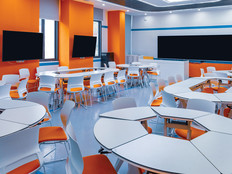Lines Blur Between K-12 and College: What It Means for IT Leaders
In July 2019, Pennsylvania Gov. Tom Wolf signed a bill allowing school districts to offer up to five “cyber snow days” per year instead of canceling classes.
It’s the latest example of how comfortable K–12 educators and students have become with remote learning.
It’s also an example of how K–12 technology experiences increasingly set student expectations for what’s possible — and preferable — at the collegiate level.
Whether they’re looking for Gigabit Wi-Fi in dorms, guest speakers videoconferencing into classrooms or the availability of esports programs, today’s high school juniors and seniors often scrutinize a college’s technology options when deciding where to apply.
As those trends play out in K–12, they create opportunities for higher education.
For example, high school students can take early college courses online or attend remotely via distance-learning technology.
A great user experience with one college’s offerings could convince a student to put that college on his or her short list — a recruiting opportunity that didn’t exist just a generation ago.
Rather than a hard line between secondary and post-secondary education, we’re seeing a broader ecosystem. As a result of these shifts, K–12 is increasingly influencing the way colleges and universities strategize their IT investments and rethink the user experience.
MORE FROM EDTECH: Check out how universities are adopting K–12's one-to-one device program.
Higher Education’s Modern Pedagogy Is the Norm for Gen Z
Accompanying these new opportunities are new pressures, and they’re about to ramp up as Generation Z students come to campus. Even more than their recent predecessors, these learners expect a mobile-first, digital-first experience, with seamless consumption of content being second nature.
A growing number of solutions make this type of service delivery possible: cloud-based software, interactive whiteboards with associated apps, virtual desktop infrastructure and videoconferencing, to name the big ones.
But unless institutions are prepared to invest in these, and unless faculty and staff are prepared to support effective classroom and campus integrations, there may remain a disappointing gap between students’ expectations and reality.
Increasingly, students expect to be able to go from residence halls to classrooms to off-campus activities, all while being able to work on assignments and, if need be, attend class remotely.
Colleges that have embraced these solutions report increases in engagement and collaboration. At Case Western Reserve University, Microsoft Surface Hubs support an institution-wide commitment to problem-based, collaborative learning.
Cisco Webex Boards and the Teams app help students connect inside and outside of class at the University of Wisconsin-Whitewater.
These changes go deeper than convenience, reflecting fundamental shifts in pedagogy in both K–12 and higher education. Many institutions are investing heavily in classrooms and buildings designed to facilitate active learning.
These classrooms, providing multidirectional content sharing and flexibility in the use of physical spaces, represent drastic change to instructors accustomed to row seating and lecture-style teaching.
But for today’s college students, these modern spaces are normal. As a result, colleges seeking to differentiate themselves as technologically advanced institutions would do well to incorporate modern classrooms into strategic plans (and budget accordingly).
Consumer Experiences Shape Students’ Expectations of Campus Services
Gen Z students are also more likely to base their expectations as learners on their experiences as consumers. As retailers offer personalized, simple and timely engagement via the Internet of Things, chatbots, custom content and other strategies, students wonder why their interactions with higher education can’t be just as rewarding.
Some universities, such as the University of Alabama at Birmingham, are adamant that nothing should prevent higher education from offering the same caliber of service.
Vice President for IT and CIO Curtis Carver spoke about using technology to transform cumbersome, time-consuming interactions into streamlined, student-friendly experiences at UAB. That mindset is essential for institutions that want to stave off competition and shine as the type of campus that understands — and delivers — what today’s learners want.
The jump from K–12 schooling to higher education should be a logical transition, moving students from high school subject matter to the liberal arts and career-readiness focus of college instruction. Students shouldn’t have to shift backward when it comes to their classroom technology and campus services.
This article is part of EdTech: Focus on Higher Education’s UniversITy blog series.











